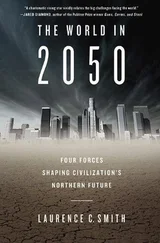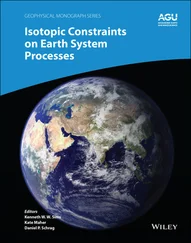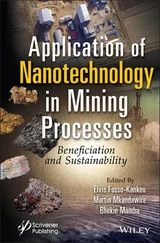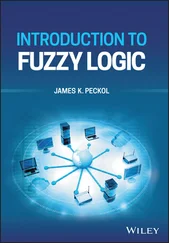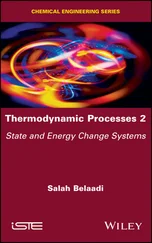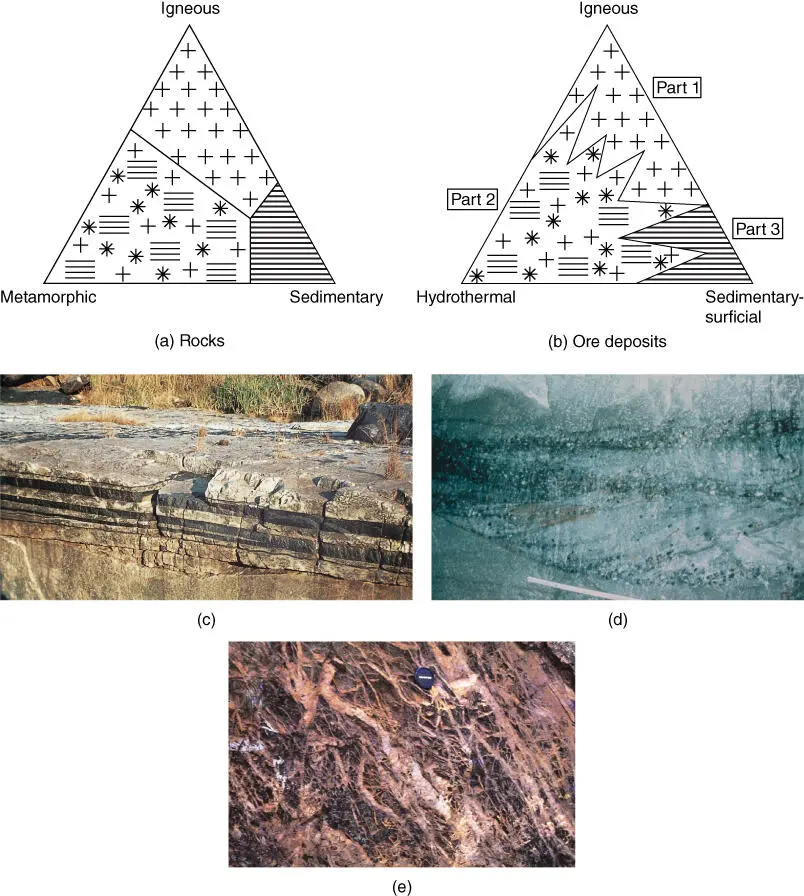
Figure 1(a) Classification of the principal rock types and (b) a simple classification of ore deposits also based on host rock type – Parts 1, 2, and 3 represent the breakdown of sections in this book. Photographs illustrate examples representing the main ore forming processes. (c) Igneous: magmatic layering and chromitite seams, Critical Zone, Bushveld Complex, South Africa. (d) Sedimentary: Au‐ and U‐bearing conglomerate from the Witwatersrand Basin, South Africa. (e) Hydrothermal: quartz‐carbonate vein network in metasedimentary host rocks of the Lily gold mine, Barberton greenstone belt, South Africa.
The main part of this book is subdivided into three sections termed Igneous (Part I), Hydrothermal (Part II), and Sedimentary/Surficial (Part III) ( Figure 1a–e). Part I comprises Chapters 1and 2, which deal with igneous and magmatic‐hydrothermal ore‐forming processes respectively. Part II contains Chapter 3and covers the large and diverse range of hydrothermal processes not covered in Part I. Part III comprises Chapter 4on surficial and supergene processes, as well as Chapter 5, which covers sedimentary ore deposits, including a section on the fossil fuels. The final chapter of the book, Chapter 6, is effectively an addendum to this threefold subdivision and is an attempt to describe the distribution of ore deposits, both spatially in the context of global tectonics and temporally in terms of crustal evolution, through Earth history. This chapter is relevant because the plate tectonic paradigm, which has so pervasively influenced geological thought since the early 1970s, provides another conceptual basis within which to classify ore deposits. In fact, modern economic geology, and the scientific exploration of mineral deposits, is now firmly cast into the frame of global tectonics and crustal evolution. Although there is still a great deal to be learnt, the links between plate tectonics and ore genesis are now sufficiently well established that studies of ore deposits are starting to contribute to a better understanding of the Earth system.
What Makes a Viable Mineral Deposit?
Ore deposits form when a useful commodity is sufficiently concentrated in an accessible part of the Earth's crust so that it can be profitably extracted. The processes by which this concentration occurs are the topic of this book. As an introduction it is pertinent to consider the range of concentration factors that characterize the formation of different ore deposit types. Some of the strategically important metals, such as Fe, Al, Mg, Ti, and Mn, are abundantly distributed in the Earth's crust (i.e. between about 0.5% and 10%) and only require a relatively small degree of enrichment in order to make a viable deposit. Table 1shows that Fe and Al, for example, need to be concentrated by factors of 9 and 4 respectively, relative to average crustal abundances, in order to form potentially viable deposits.
Table 1Average crustal abundances for selected metals and typical concentration factors that need to be achieved in order to produce a viable ore deposit.
Source: Average crustal abundances from Rudnick and Gao (2014). Reproduced with permission of Elsevier.
|
Average crustal abundance |
Typical exploitable grade |
Approximate concentration factor |
| Al |
8.4% |
30% |
×4 |
| Fe |
5.2% |
50% |
×9 |
| Cu |
27 ppm |
1% |
×370 |
| Ni |
59 ppm |
1% |
×170 |
| Zn |
72 ppm |
5% |
×700 |
| Sn |
1.7 ppm |
0.5% |
×2900 |
| Au |
1.3 ppb |
2 g t −1 |
×1500 |
| Pt |
1.5 ppb |
5 g t −1 |
×3300 |
Note : 1 ppm is the same as 1 g t −1.
By contrast, base metals such as Cu, Zn, and Ni are much more sparsely distributed and average crustal abundances are only in the range 30–70 parts per million (ppm). The economics of mining dictate that these metals need to be concentrated by factors in the hundreds in order to form potentially viable deposits – degrees of enrichment that are an order of magnitude higher than those applicable to the more abundant metals. The degree of concentration required for the precious metals is even more demanding, where the required enrichment factors are in the thousands. Table 1shows that average crustal abundances for Au and Pt are in the range 1–2 parts per billion (ppb) and even though mines routinely extract these metals at grades of around 1–5 g t −1, the enrichment factors involved are between 1000 and 3000 times.
Another useful way to distinguish between the geochemically abundant and scarce metals is to plot average crustal abundances against production estimates. This type of analysis was first carried out by Skinner (1976), who used a plot like that in Figure 2to confirm that crustal abundance is a reasonable measure of the availability of a given resource. It is by design and of necessity that we use more of the geochemically abundant metals than we do the scarce ones. The nature of our technologies and the materials we use to manufacture mechanical items depend in large measure on the availability of raw materials. As an example, the technologies (geological and metallurgical) that resulted in a dramatic increase in global aluminum production over the latter part of the twentieth century, allowed iron to be replaced by aluminum in many products such as motor vehicles. More importantly, though, Figure 2allows estimates to be made of the relative rates of depletion of certain metals relative to others. These trends are discussed again below.

Figure 2Plot of global production against crustal abundances for a number of metal commodities. The line through Fe can be regarded as a datum against which the rates of production of the other metals can be compared in the context of crustal abundances.
Source: After Einaudi (2000).
Mineral Resources and Ore Reserves
Throughout this book reference is made to the term “ore deposit” with little or no consideration of whether such occurrences might be economically viable. Although such considerations might seem irrelevant in the present context, it is necessary to emphasize that professional institutions now insist on the correct definition and usage of terminology pertaining to exploration results, mineral resources, and ore reserves. Such terminology should be widely used and applied, as it helps to reduce the incorrect, and sometimes irresponsible, usage of terminology in reports on which, for example, investment decisions might be based. Correct terminology can also assist in the description and identification of genuine ore deposits from zones of marginal economic interest or simply anomalous concentrations of a given commodity.
Although the legislation that governs the public reporting of mineral occurrences varies from one country to another, there is now reasonable agreement globally on a definition of terms. It is widely accepted that different terms should apply to mineral occurrences depending on the level of knowledge and degree of confidence that is associated with their quantification in terms of grade and mass/volume. Figure 3is a matrix that reflects the terminology associated with an increased level of geological knowledge and confidence, and modifying factors such as those related to mining techniques, metallurgical extraction, marketing, and environmental reclamation. Exploration results can be translated into a mineral resource once it is clear that an occurrence of intrinsic economic interest exists in such form and quantity that there are reasonable prospects for its eventual exploitation. Such a resource can only be referred to as an ore reserve if it is a part of an economically extractable measured or indicated mineral resource. One problem with this terminology is that an economically extractable ore deposit in a developing world artisanal operation may not be viable in a technically developed economy, and vice versa. The term “ore deposit” has no significance in the professional description of a mineral occurrence and is best used simply as a descriptive or generic term.
Читать дальше







